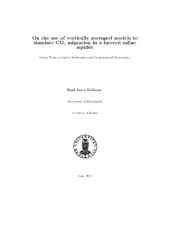| dc.description.abstract | Geologic and flow characteristics such as permeability and porosity, capillary pressure, geologic structure, and thickness all influence and affect CO2 plume distribution to varying degrees. These parameters do not necessarily act independently. Depending on the variations in these parameters one may dominate the shape and size of the plume. In this master thesis, we consider the long-term fate and migration of a large CO2 plume that takes place in a heterogeneous (two-layer) sloping saline aquifer. We consider a vertical equilibrium (VE) mathematical model to study the effect of two different permeability layers on the shape, speed and migrated distance of the CO2 plume. The layer-permeability-ratio is k2/k1, where k2 and k1 are the permeabilities in the upper and lower layer of the aquifer, respectively. We also study the effect the thickness ratio of the lower permeability(h=H/2, h=H/4, h=H/8), where H is the thickness of the aquifer. We attain these goals by comparing the simulation results of Eclipse and VE simulators, where both simulate the movement of CO2 plume in homogeneous and layered aquifers. A VE model has been built considering one-dimensional flow in the x-direction, due to the big difference in scale length between vertical and horizontal directions. We model a 2D vertical section in Eclipse simulator, taking the vertically averaged of this section ends up with a 1D results that can compared with the VE solution. Our results shows that the variations in the vertical permeability layers may have a dramatic effects on the CO2 plume shape. Relatively lower permeability layer reduces the velocity of CO2 through it, and an increase of CO2 saturation occurs below this layer. At early time, the build up in saturation increases, and the lateral growth of the CO2 immediately below this layer increases. At later time, the saturation decreases and the vertical flow of the CO2 in this layer increases. The k2/k1 ratio and thickness of the lower permeability layer determines the plume shape and distance migrated. In some of our simulations, the results show two connected/disconnected plumes. | en_US |
